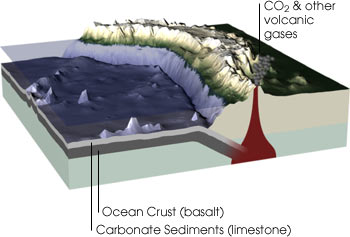Carbon in the Atmosphere
Carbon Flux
The movement of carbon between reservoirs is carbon flux. Various processes—including chemical, physical, geological, and biological—enable the movement of carbon. Carbon moves between reservoirs at varying rates ranging from minutes to millions of years.

Flux between carbon in the food and water we ingest and the air we breathe is small. Flux between carbon in vegetation and soils and the atmosphere and between the ocean and the atmosphere is large.

On longer time scales, carbon moves from the atmosphere, through the ocean and into sediments, which are subducted into the mantle, along with the ocean lithosphere, which melts so that the carbon returns to the atmosphere through volcanoes.
The concepts of carbon reservoirs and fluxes are very important to understand the carbon cycle.

